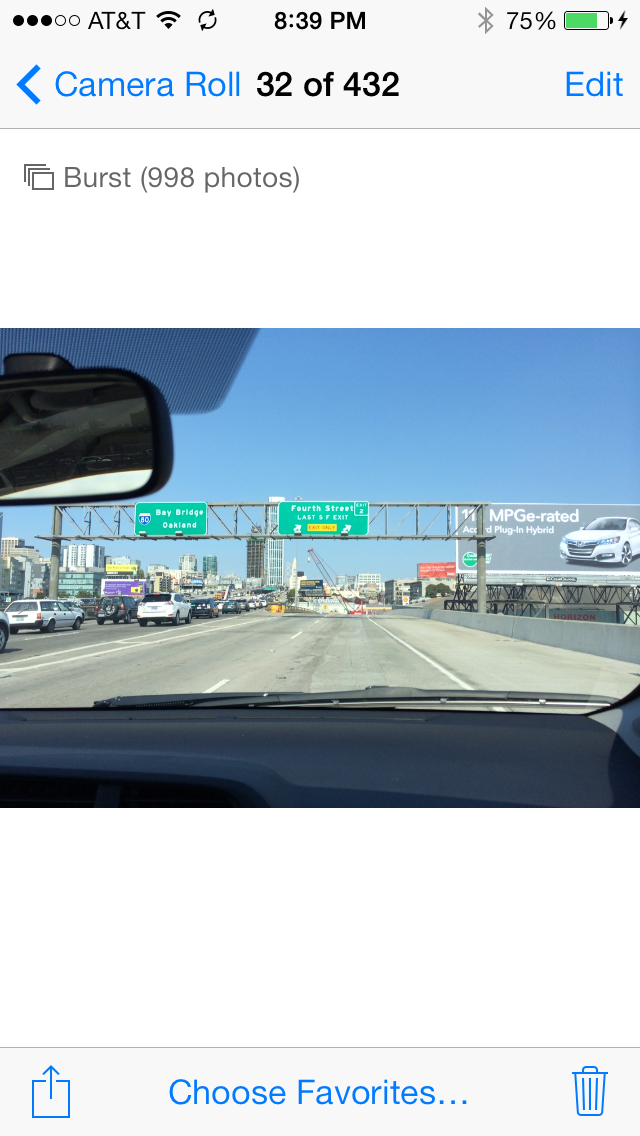The iPhone 5s Review
by Anand Lal Shimpi on September 17, 2013 9:01 PM EST- Posted in
- Smartphones
- Apple
- Mobile
- iPhone
- iPhone 5S
Camera
The iPhone 5s continues Apple’s tradition of sensible improvements to camera performance each generation. I was pleased to hear Phil Schiller deliver a line about how bigger pixels are a better route to improving image quality vs. throwing more at the problem. I remember hearing our own Brian Klug deliver almost that exact same message a year earlier when speaking to some engineers at another phone company.
The iPhone 5s increases sensor size compared to the iPhone 5. Last week Brian dug around and concluded that the 5s’ iSight camera sensor likely uses a format very similar to that of the HTC One. The difference here is while HTC opted for even larger pixels (arriving at 4MP), Apple chose a different balance of spatial resolution to light sensitivity with its 8MP sensor.
One thing ingrained in my mind from listening to Brian talk about optics is that there is no perfect solution, everything ultimately boils down to a selection of tradeoffs. Looking at Apple/HTC vs. the rest of the industry we see one set of tradeoffs, with Apple and HTC optimizing for low light performance while the rest of the industry chasing smaller pixel sizes. Even within Apple and HTC however there are differing tradeoffs. HTC went more extreme in pixel size while Apple opted for more spatial resolution.
| iPhone 4, 4S, 5, 5S Cameras | ||||
| Property | iPhone 4 | iPhone 4S | iPhone 5 | iPhone 5S |
| CMOS Sensor | OV5650 | IMX145 | IMX145-Derivative | ? |
| Sensor Format |
1/3.2" (4.54x3.42 mm) |
1/3.2" (4.54x3.42 mm) |
1/3.2" |
~1/3.0" (4.89x3.67 mm) |
| Optical Elements | 4 Plastic | 5 Plastic | 5 Plastic | 5 Plastic |
| Pixel Size | 1.75 µm | 1.4 µm | 1.4 µm | 1.5 µm |
| Focal Length | 3.85 mm | 4.28 mm | 4.10 mm | 4.12 mm |
| Aperture | F/2.8 | F/2.4 | F/2.4 | F/2.2 |
| Image Capture Size |
2592 x 1936 (5 MP) |
3264 x 2448 (8 MP) |
3264 x 2448 (8 MP) |
3264 x 2448 (8 MP) |
| Average File Size | ~2.03 MB (AVG) | ~2.77 MB (AVG) | ~2.3 MB (AVG) | 2.5 MB (AVG) |
Apple moved to 1.5µm pixels, up from 1.4µm in the iPhone 5. Remember that we’re measuring pixel size in a single dimension, so the overall increase in pixel size amounts to around 15%. Apple also moved to a faster aperture (F/2.2 vs. F/2.4 on the iPhone 5) to increase light throughput. The combination can result in significantly better photos than the outgoing 5 when taking photos in low light.
With the move to larger pixels, Apple has done away with its 2x2 binning mode in low light settings. The iPhone 5 would oversample each pixel after scene brightness dropped below a certain threshold to improve low light performance. The oversampled image would then be upscaled to the full 8MP, trading off spatial resolution for low light performance. The iPhone 5s doesn’t have to make this tradeoff. In practice I didn’t find any situations where the 5s’ low light performance suffered as a result. It always seemed to produce better shots than the iPhone 5.
Unlike some of the larger flagships we’ve reviewed lately, the iPhone 5s doesn’t ship with optical image stabilization (OIS). We’ve seen devices from HTC, LG and Nokia all ship with OIS, and have generally been pleased with the results. It’s not a surprise that the 5s doesn’t come with OIS as it’s largely the same physical platform as the outgoing 5. Still it would be great to see an Apple device ship with OIS. Perhaps on a larger iPhone.
As is always the case in space constrained camera systems, what Apple could not achieve in the physical space it hopes to make up for computationally. The 5s leverages electronic image stabilization as well as automatic combination of multiple frames from the capture buffer in order to deliver the sharpest shots each time.
Apple’s cameras have traditionally been quite good, not just based on sensor selection but looking at the entire stack from its own custom ISP (Image Signal Processor) and software. With the A7 Apple introduces a brand new ISP. Although we know very little about the new ISP, you can find references to Apple’s H6 ISP if you dig around.

Apple continues to ship one of the better auto modes among smartphone cameras I've used. I still want the option of full manual controls, but for most users Apple's default experience should be a very good one.
Capturing shots under iOS 7 is incredibly quick. Shot to shot latency is basically instantaneous now, thanks to a very fast ISP and the A7’s ability to quickly move data in and out of main memory. It’s impossible to write shots to NAND this quickly so Apple is likely buffering shots to DRAM before bursting them out to non-volatile storage.
The new ISP enables a burst capture mode of up to 10 fps. To active burst mode simply hold down the shutter button and fire away. The iPhone 5s will maintain a 10 fps capture rate until the burst counter hits 999 images (which was most definitely tested). Although it took a while to write all 999 images, all of them were eventually committed to NAND.
Photos captured in burst mode are intelligently combined as to not clutter your photo gallery. The camera app will automatically flag what it thinks are important photos, but you’re free to choose as many (or as few) as you’d like to include in your normal browsing view. Since all of the photos captured in burst mode are physically saved, regardless of whether or not you select them to appear among your photos, you can always just pull them off the 5s via USB.
The rear facing camera is paired with a new dual-LED True Tone flash. Rather than featuring a single white LED to act as a flash, Apple equips the iPhone 5s with two LEDs with different color tones (one with a cool tone and one with a warm tone). When set to fire, the 5s’ ISP and camera system will evaluate the color temperature of the scene, pre-fire the flash and determine the right combination of the two LEDs to produce the most natural illumination of the subject.
I’m not a huge fan of flashes, but I have to say that in a pinch the True Tone flash is appreciably better than the single LED unit on the iPhone 5. Taking photos of people with the new True Tone flash enabled produces much warmer and more natural looking results:
Even if your subject happens to be something other than a person I’ve seen really good results from Apple’s True Tone flash.
I still believe the best option is to grab your photo using natural/available light, but with a smartphone being as portable as it is that’s not always going to be an option.
I have to say I appreciate the vector along which Apple improved the camera experience with the iPhone 5s. Improving low light performance (and quality in low light situations where you’re forced to use a flash) is a great message to carry forward.
Front Facing Camera
The iPhone 5s and iPhone 5c share the same upgraded front-facing FaceTime HD camera. The front facing camera gets a sensor upgrade, also with a move to larger pixels (1.9µm up from 1.75µm) while resolution and aperture remain the same at 720p and F/2.4. The larger sensor size once again improves low light performance of the FaceTime HD camera (iPhone 5 left vs. iPhone 5s right):
































464 Comments
View All Comments
Bragabondio - Thursday, September 19, 2013 - link
Great review. Anand is an Apple fanboy (meaning he is an active user of mac, iphone and ipad) so he has bias towards the ecosystem but his reviews are top notch regardless of his personal preferences. Although I do not necessary always agree with him I respect his technical acumen and his desire to look deeper and discover things that most casual observers miss.I would like to see an update on :
a) GPS - how the navigation has improved (or not) in ios7 perhaps testing it head to head vs. Nexus 4 or 5 (in case he has a prototype) during a ride;
b) speaker quality - this is subjective but perhaps at least loudness and is it mono or stereo
c) phone calls quality - yes this depends on the carrier but again a subjective evaluation would be appreciated.
A few comments on the actual review.
graphic tests
I love to see improvements in the graphics quality of ARM devices although I practically do not play games on my phone. Hopefully, Apple's example will push the industry towards faster development.
Missing AC Wi-Fi is a bummer
Regarding future-proofing I disagree with Amand it is not the CPU or GPU but the 4 inch screen is too small for web reading and the trend towards larger devices will continue thus unless you really like the screen and OS (I bet when Iphone 6 is revealed with 4.5 inch screen Anand will say that yes, it is hard to go back to iphone 5 :)
WoodyPWX - Wednesday, September 18, 2013 - link
For the web browsing battery life benchmark, it would be better to have also the number of reloads executed and the energy spent for one reload (computed from those two). There are two problems it could help solve. First, slow reloads caused by a slow connection most probably force CPU to sleep, so they actually save battery and favorize worse device. Second, faster CPU processes a web page much faster. It could draw more energy but for shorter time, so it would be a win in a normal situation. Unfortunately that's not the case in your benchmark, where another reload immediately follows. Energy spent on each reload could prove here on the 5s it will stay longer in real life situations and that's what I'm interested in.sfaerew - Wednesday, September 18, 2013 - link
you are right!jeffkro - Wednesday, September 18, 2013 - link
Looks kind of like the HTC one.joshjw - Saturday, September 21, 2013 - link
Well i think what you are trying to say is that the HTC one looks a lot like the Iphone because the 5s looks identical to the 5 except for the home button and the 5 was released before the HTC 1tipoo - Wednesday, September 18, 2013 - link
So what was up with the Infinity Blade 3 guys saying it loaded 5X faster on the 5S? How much faster is the NAND, exactly?Sabresiberian - Wednesday, September 18, 2013 - link
Apple, so far, has proved me wrong. I said they were going to be a cell phone dead end eventually a few years ago, but they have continued to innovate. The fact that they designed their own SoC has very much impressed me.I'm a PC guy, I'm a Windows guy; but I recognize a commitment to making a product better when I see one. Well done Apple!
If Microsoft wants to grab more smart phone market share, then they could do well to emulate Apple in this regard. Moral of the story here is - don't follow, lead!
slickr - Thursday, September 19, 2013 - link
Anand is a shill for the NSA, don't trust the retard. He is there to tell you to buy a spy system that scans your face, that scans your fingertip and has your full name and all other information.This is the NSA's dream, a spy device masquerading as phone that shills like Anand the retard push.
dugbug - Thursday, September 19, 2013 - link
Your tin foil budget must be quite largehulkkii - Thursday, September 19, 2013 - link
How fast is the camera compared to iPhone 5? (Can you test with CamSpeed)?